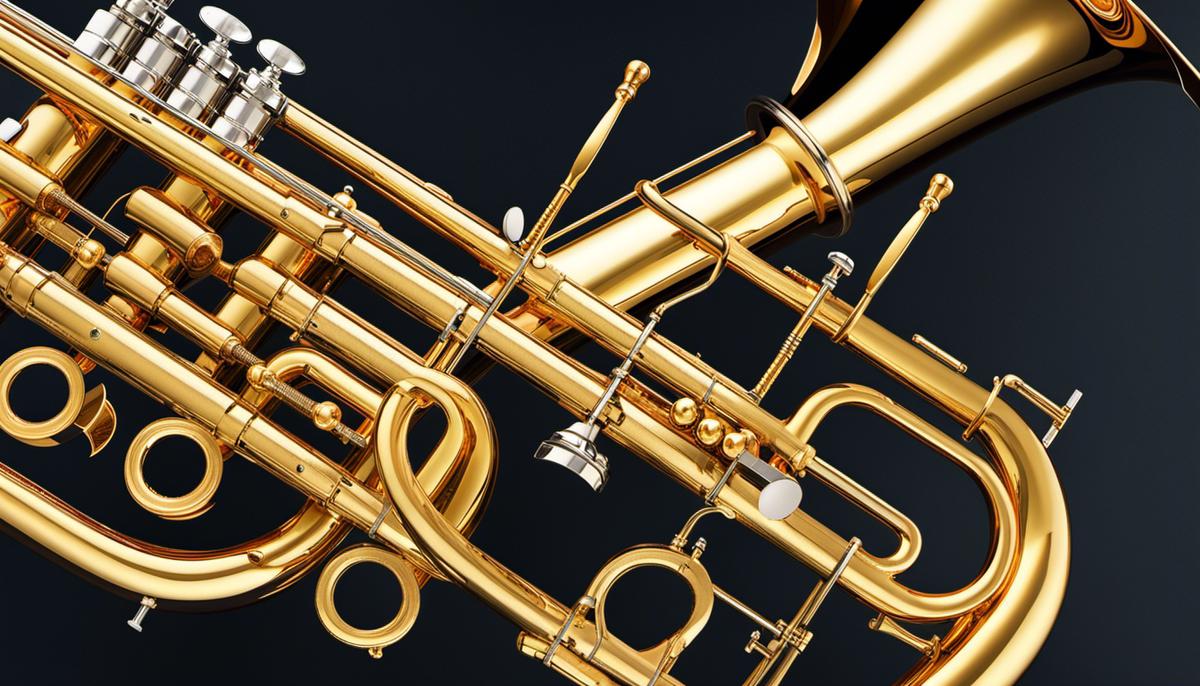Table of Contents
Introduction
For any enthusiast or hobbyist looking to master the art of performing low brass excerpts, it’s essential to embrace a multidimensional understanding of the task at hand. Whether you’re delving into the complex nuances of classical, jazz, pop or rock music, or navigating the intricacies of note articulation, breath control, and embouchure formation, proficiency lies at the intersection of knowledge, technique, and interpretation. In this discourse, we’ll dissect the process of recognizing key low brass excerpts, comprehending requisite performance techniques, developing effective practice strategies, interpreting musical aspects, and finally, delivering a captivating performance.

Identifying Key Low Brass Excerpts
Understanding Low Brass Excerpts
Low brass excerpts consist of specific sequences of music pieces played primarily by the low brass instruments, such as the trombone, tuba, euphonium and baritone horn. These excerpts are essential learning tools for enthusiasts aiming to improve their technical skill, musical expression, and understanding of different musical styles and periods.
Classical Low Brass Excerpts
Among the most frequently chosen pieces for low brass excerpts are those from the classical music period. Excerpts from Ludwig van Beethoven’s Symphony No. 9 or Gustav Mahler’s Symphony No. 3, for example, challenge low brass players’ control, tone, and expressive abilities. Other popular choices include excerpts from the works of Johannes Brahms and Richard Wagner, whose pieces require advanced technical proficiency and a comprehensive understanding of the stylistic requirements of classicism.
Jazz Low Brass Excerpts
Jazz music provides a rich foundation for low brass excerpts. The improvisational nature and rhythmic complexity of jazz offer a unique challenge for low brass players. Excerpts from compositions by jazz greats like Duke Ellington, Count Basie, or Charles Mingus often focus on syncopation, complex chord changes, improvisation techniques, and expressive use of dynamics and articulation.
Pop and Rock Low Brass Excerpts
Pop and rock pieces aren’t usually associated with low brass instruments, but some musicians have incorporated these styles into their repertoire. These pieces often feature simpler melodic and rhythmic structures compared to classical and jazz music. However, they highlight important techniques such as slide glissando, used extensively in rock music and pop flair, and rhythmic precision, critical in pop music with its usual steady beat.
Difficulty Levels and Techniques
The difficulty level of low brass excerpts can vary widely. Simple excerpts may involve only a few notes and basic rhythms, making them suitable for beginners. More complex excerpts can challenge even expert players, requiring advanced techniques such as high-range playing, swift slide or valve action, double tonguing, or circular breathing. Key to mastering these excerpts is understanding the individual techniques required and practicing them systematically.
Variations in Styles and Periods
The style and period of the piece significantly influence the way low brass excerpts need to be played. For example, Baroque and Classical period music demand exactness in rhythm and strict adherence to the notated score. Meanwhile, Romantic period pieces require more emotional expressiveness and flexibility in tempo. Jazz and pop/rock, on the other hand, often emphasize personal style and improvisation over strict adherence to the written note.
Understanding the Significance of Low Brass Excerpts
The significance of low brass excerpts in the realm of music cannot be overstated, especially for enthusiasts or hobbyists determined to improve their technique. By diligently learning and perfecting these excerpts, musicians not only acquire a deep understanding of various musical styles but also enhance their technical skills. Furthermore, given that these excerpts are often integral to auditions for ensembles or solo performances, mastering them can be pivotal for those eager to progress in their musical endeavors.
Understanding Low Brass Techniques
Mastering Crucial Techniques for Successful Low Brass Excerpt Performance
Accurate execution of popular low brass excerpts requires a strong command over several fundamental techniques. Paramount among these are note articulation, breath control, and embouchure formation. Gaining proficiency in these areas can significantly elevate a performer’s ability to deliver a smooth, skillful, and memorable rendition of these important musical pieces.
Articulation Technique
Note articulation talks about the way each note is played or expressed. For a low brass instrument—such as the trombone, tuba, euphonium, and baritone—this involves knowing the necessary tongue motion and air speed for each note. For example, to create staccato, players make sharp bursts of air and keep their tongues high in their mouths. Articulating notes correctly allows for a more accurate, richer sound and paves the way for nuance and subtlety in your performances.
Breath Control Technique
Breath control is fundamental to almost any wind instrument but particularly crucial when it comes to low brass. Considering the larger size of these instruments, they require a great amount of air for effective sound projection. Learning how to inhale quickly and deeply while keeping a steady exhalation as you play is key to maintaining an even, controlled sound. One popular technique is circular breathing, in which players inhale through their noses while maintaining note production by forcing previously-held air out through the instrument.
Embouchure Formation Technique
Embouchure refers to how you position and use your lips, tongue, and facial muscles when playing a brass instrument. With low brass instruments, it’s common to have a relatively relaxed embouchure, with the lower lip slightly forward. It’s important to remember that each player’s optimal embouchure may look slightly different due to differing facial structures. A well-formed embouchure is vital to producing a clear tone and precise intonation.
Technical Studies for Low Brass
To become proficient in playing low brass excerpts, it’s beneficial to practice scales, arpeggios, lip slurs, and some technical exercises. This will enhance finger or slide technique, depending on the instrument.
For low brass instrument players, it’s vital to commit to regular practice sessions focused specifically on these techniques, play slow and gradually increase the speed. Patience and consistency in practice sessions foster accuracy and confidence, requisite for playing popular low brass excerpts to the best of your ability.
Keep in mind that the techniques you’ll be learning aren’t isolated elements – instead, they interconnect to help you craft a successful performance. Indeed, practicing these techniques in tandem is instrumental in delivering fluid renditions of low brass excerpts.
Effectively Practicing Low Brass Excerpts
Unlocking Proficiency through a Comprehensive Understanding of Low Brass Excerpts
Low brass excerpts constitute a meaningful segment of musical pieces featuring the low brass family of instruments, which includes the tuba, trombone, euphonium, and the lower-register horns like the bass trombone and contrabass trombone. These excerpts are frequently used in auditions or adopted as learning resources to better technique and musicality. Grasping and mastering these excerpts can significantly amplify your performance abilities.
Establishing a Practice Routine for Low Brass Excerpts
A well-structured practice routine is central to mastering low brass excerpts. Begin by setting aside a specific time each day for practice. Consistency is key, as it allows for gradual progression and improvement. Divide your practice time into various activities. Dedicate time to warm-up exercises, which are crucial for flexibility and maintaining a good tone quality. Spend an ample amount of time working on technical exercises, which will enhance your agility and proficiency. Lastly, carve out time to practice and perfect your excerpts.
Implementing Slow Practice and Repetition
Slow practice and repetition are two techniques that significantly help in mastering difficult passages in these excerpts. Begin by playing the excerpt significantly slower than the desired performance speed. This will help you fully comprehend the technical demands and musical nuances of the piece. As you become more comfortable with the music at a slow pace, gradually increase the speed until you reach, and can maintain, the excerpt’s required tempo. Repetition, when done correctly, allows your mind and muscles to become accustomed to the piece, promoting technical efficiency. Remember not to mindlessly repeat passages, but focus on improving specific aspects with each repetition.
Strategies for Learning Difficult Sections
In particularly challenging sections of the excerpts, isolation can be an effective strategy. Identify the most challenging measures or phrases and tackle them separately from the rest of the piece. Work on difficult rhythms, large leaps, or rapid passages. Once these difficult parts are mastered, they can be re-integrated into the complete excerpt. Visualizing the ideal sound or technique beforehand can also contribute to better performance.
Enhancing Performance with Recordings and Metronomes
Listening to professional recordings of low brass excerpts can offer valuable insights into interpretations and styles. Replicate phrasing, articulation, and dynamics to refine your own interpretation. A metronome can also be a helpful practice tool. Using a metronome ensures consistent pacing and helps to learn complex rhythms or tempos.
Importance of Regular Feedback
Regular feedback, preferably from a skilled instructor or peer, can provide another dimension to your practice. They can judge your performance more objectively and spot potential issues or areas for improvement. Incorporating these into your practice routine will make your learning more effective and efficient.
Mastering low brass excerpts is a journey that requires patience, persistence, and dedicated hard work. You may encounter hurdles, but it’s important to celebrate every small win and every inch of progress. As you pour in your focused efforts and enthusiasm, the captivating and deep tones of low brass will eventually become a part of your musical vocabulary.
Interpreting Low Brass Excerpts
Demystifying Low Brass Excerpts: Phrasing, Dynamics, and Emotional Expression
Developing proficiency in low brass excerpts necessitates a profound understanding of the fundamental elements of music: phrasing, dynamics, and emotional expression. Phrasing, much like creating sentences in a language, involves crafting the melody by skillfully linking and balancing the notes. Recognizing the start and finish of each phrase helps ensure the musical idea remains coherent and intact.
A crucial aspect that intensifies the depth of any music piece is dynamics, referring to variations in volume and intensity. Whether a particular piece demands a robust fortissimo or a delicate and subtle pianissimo, adhering to these instructions significantly enhances the impact of your performance.
Music is a vibrant canvas of emotions, and each piece encapsulates feelings the composer aims to communicate, ranging from joy and sorrow to anger or a blend of complex emotions. Immerse yourself in the music, grasp its emotional core, and strive to channel these feelings to your audience. As you explore and reconstruct the emotional landscape of a piece, you add a vivid life to its performance.
Understanding the Role of Excerpts in the Larger Composition
Comprehending the role an excerpt plays in a complete musical piece is vital for a precise interpretation. Each low brass excerpt plays a unique role within the overall score, serving different purposes such as introducing themes, creating dramatic highs, or bringing a gentle closure. Understanding this broad context can significantly improve your performance, delivering a richer musical narrative that seamlessly connects with the music before and after the excerpt.
Part of this process involves delving into the composer’s intentions and stylistic choices. Thorough research about the composer and the era of the piece can yield insightful tips on the stylistic approach that best suits an excerpt. For instance, a section from Brahms’s symphony will likely require a quite different approach than a thunderous segment in a John Williams’ film score.
Lastly, it’s crucial to recognize that the function and application of the low brass in music has progressed over time. While earlier orchestral compositions often used low brass instruments more for support or reinforcement, more recent works allow them to take on more thematic roles. This should be taken into account when you are interpreting any popular low brass excerpt.
Performing Low Brass Excerpts
Deciphering Popular Low Brass Excerpts
Low brass excerpts, the sections of a musical score intended for trombones, tubas, and other low-toned brass instruments, are frequently sourced from sonatas, symphonies, concertos, and other orchestral masterpieces by celebrated composers such as Beethoven, Mozart, or Mahler. Proficiency in these celebrated excerpts can catapult your overall playing skills to new heights. It not only enhances your performance in live concerts but also helps you excel in studio recordings.
Choosing the Right Excerpt
Choosing the right excerpt to study and perform is crucial. Perhaps it would be best to start with more manageable pieces to build confidence and gradually improve your skills. Once you feel more comfortable, you can move on to more challenging excerpts. It’s also important to listen to different recordings of these works to understand the different interpretations and styles.
Dealing with Performance Anxiety
Performance anxiety can significantly affect your performance, and it can strike at any time, even when you’re playing well-known low brass excerpts. Regular practice can help to mitigate performance anxiety, but you might want to consider other strategies such as deep breathing exercises, visualization techniques, and positive affirmations. Additionally, adopting a healthy lifestyle that includes a balanced diet, regular exercise, and proper sleep can also help manage anxiety levels.
Perfecting Stage Presence
When performing low brass excerpts, your stage presence can have a significant impact on your overall performance. This doesn’t just mean how you look on stage – it’s about your entire demeanor. Always show confidence and engagement with your audience. Use your body language to communicate your enthusiasm for the music, and express the emotion of the piece through your facial expressions.
Effective Communication with the Audience
Unlike vocalists, instrumentalists like low brass players do not have lyrics to help communicate the meaning of the music. However, your playing itself can still resonate with the audience emotionally. Your dynamic range, articulation, phrasing, and overall musicality can help create an emotional experience, even if the audience doesn’t understand the technical aspects of the music.
Considering Physicality and Instrument Care
Playing a low brass instrument requires physical stamina, so be aware of your health and take care of your body. Similarly, your instrument should be maintained properly – a poorly maintained low brass instrument could negatively impact your performance. Regular cleaning and professional servicing when necessary can help your instrument deliver optimal sound.
Expanding Your Repertoire
As you progress, it’s important to continually challenge yourself and expand your repertoire. Try different eras and styles, such as Baroque, Classical, and Contemporary. By exposing yourself to a wide range of music, you will become a more accomplished and versatile performer. Besides, continuously learning new pieces will not only help you improve as a musician but also keep you engaged and excited about your craft.
Conclusion
Remember, becoming proficient at playing low brass excerpts doesn’t happen overnight.
It requires time, patience, and commitment. But with dedication and passion, these pieces could be a stellar showcase of your talent, impressing the audience, and judges alike. Never stop exploring new methods, techniques, and perspectives, for it is through this exploration that you transform from a low brass enthusiast into a skilled performer.
Additional Reading
Take some time to check out our other articles:
- Popular Music Industry Careers
- 10 Popular Music Jobs
- 7 Essential Music Production Tools Under $100
- AI In Music Production
Breve Music Studios publishes music to Spotify, YouTube Music, Amazon Music and more. Follow our pages on Facebook, Instagram, Twitter, TikTok, and YouTube.
Listen to our ensembles: Breve Orchestra, Breve Music Ensemble, Breve Low Brass Ensemble, Breve Woodwind Ensemble, and Jermaine Harris on Spotify.

